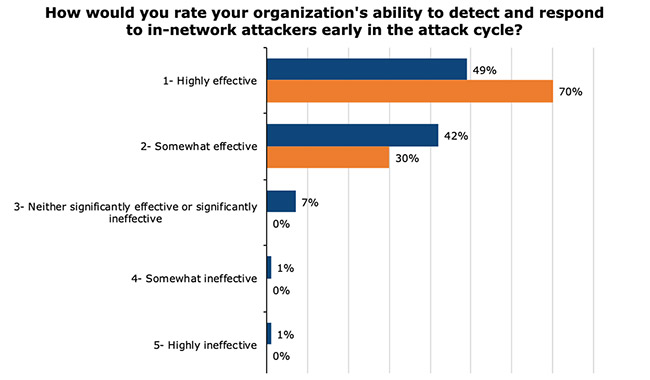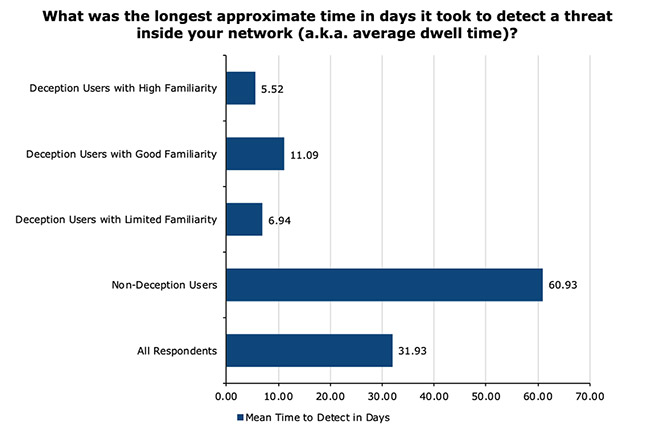Deception technology shifts power back to the defender
Users of deception technology reported a 12X improvement in the average number of days it takes to detect attackers operating within an enterprise network when compared to those unfamiliar with the technology, according to a research report conducted by Enterprise Management Associates (EMA).

EMA surveyed 208 respondents across North America in June 2019, with the majority of respondents working in IT/IS/telecoms or cybersecurity within an IT organization.
Other studies conducted by incident response service providers or endpoint detection and response vendors suggest an average of 78 to over 100 days, while survey respondents that are highly familiar users of deception technology reported dwell times as low as 5.5 days.
Seventy percent of respondents highly familiar with and currently using deception technology rated their organizations as highly effective as compared to 49% reported from the aggregate of all users, including deception technology users.
The research explored:
- The primary motivation for looking at deception technology. 67% of respondents evaluating or planning to look at deception technology cited the speed of detecting threats early in the attack lifecycle as the primary driver behind their interest.
- Nineteen different use cases including detection, ransomware, data loss tracking and counterintelligence, and insider policy violations. Notably, when respondents ranked 12 security tools for detecting insider threats, 30% ranked deception technology, tied with next-generation endpoint security, as the most effective tool in detecting insider threats.
- Respondents reported deployment environments including the cloud (27%), IoT/OT/Specialized (15%), remote locations (11%), and headquarter offices (10%), validating the utilization across diverse attack surfaces. These findings are consistent with the detection survey conducted in 2018 by Attivo Networks, where 62% of respondents rated cloud and 34% identified OT/specialized environments as the top attack surfaces of concern.
- The unique value and benefits of deception technology. The survey provided nine choices with the top five benefits cited as faster incident response (13%), detection of basic and advanced threats regardless of techniques (12%), more actionable alerts (12%), intelligence on attacker movement techniques and targets (12%), and visibility to attack paths and credential vulnerabilities (12%).
- The value of deception technology is evident as 71% of respondents cited that they have achieved a significantly to somewhat higher value from the technology than initially expected. 84% stated that they planned to increase their spending in the future.
“Attacker dwell time has become a measure of security effectiveness for many organizations, and the industry as a whole has seen incremental progress in reducing the number of days that attackers remain undetected within enterprise networks. But a 91% reduction in dwell time – down to 5.5 days – is the most dramatic decrease any study we have done has ever documented,” said Paula Musich, research director in security and risk management at Enterprise Management Associates in Boulder, Colo.

“Quantifying the ROI of security controls can be extremely challenging and is often tied to overall breach metrics that can be heavily debated,” says Carolyn Crandall, Chief Deception Officer and CMO of Attivo Networks.
“This survey is particularly interesting in that it quantifies the specific value derived and the sentiment of deception technology users compared to non-users.”
Crandall continues, “Cybersecurity has traditionally been a ‘cat and mouse game’ between IT teams and cyber attackers, with a cybercriminal’s arsenal continually evolving. Deception technology, however, shifts power back to the defender, giving organizations visibility and early detection, company-specific threat intelligence, and faster incident response.”